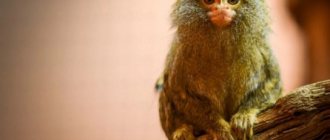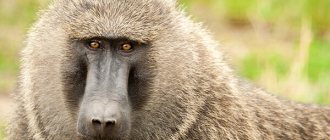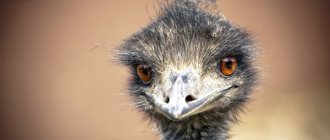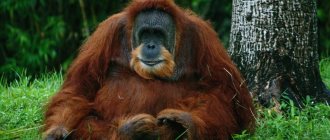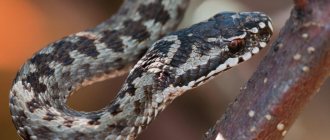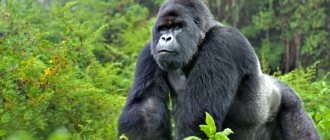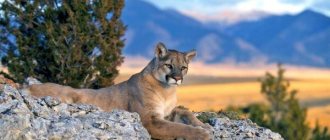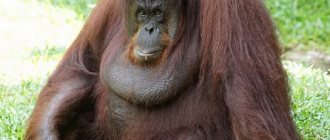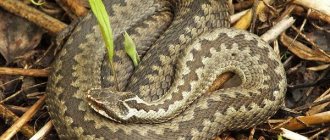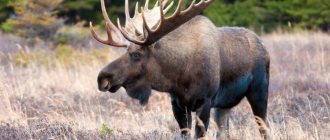Baboons are known as intelligent apes, rivaling chimpanzees in their intelligence and desire for social life. They also communicate very actively with people, and never live alone. Groups of baboons consist of 50-80 animals, led by a male. It is easy to recognize a baboon: it walks on all legs, and holds its long tail up at an angle. Baboons live in the north and east of Africa, in savannas and steppe regions, and are occasionally found in the mountains, if there are bodies of water nearby and suitable places for safe overnight stays. Baboons often visit maize and millet fields, and are not afraid of the proximity of people.
Description of baboon
Baboons are baboons from the monkey family.
They have a special skull shape and an elongated muzzle, and for this reason they are even called dog-headed monkeys. In addition, baboons are known as yellow baboons due to the yellowish-gray shade of their coat. — Advertising —
The baboon's body length is about 75 cm, its tail reaches 60 cm in length. The animal seems clumsy in appearance, but in fact it is very dexterous and agile.
further reading
- Cheney, Dorothy L.; Seyfarth, Robert M. (2007). The Metaphysics of the Baboon: The Evolution of Social Mind. Chicago: University of Chicago Press. ISBN 9780226102436.
- Zinner, Dietmar; Groeneveld, Linn F.; Keller, Christina; Roos, Christian (2009). "Mitochondrial phylogeography of baboons (Papio spp.) - indications for introgressive hybridization?" . BMC Evolutionary Biology
.
9
(83): 83. DOI: 10.1186/1471-2148-9-83. PMC 2681462. PMID 19389236.
Baboon nutritional features
The baboon is unpretentious in nutrition and is able to adapt to any food. The main thing for him is to have enough water. During droughts, these monkeys lick the morning dew from plants and even from their fur. The baboon's diet consists of leaves, roots, seeds, fruits, plant bulbs, as well as snails, fish, birds, insects, lizards, mice and other small rodents. Since these monkeys are very similar to humans in digestion, they often steal a wide variety of food from tourists.
Baboon distribution
The baboons' habitat includes northern and eastern Africa, where the animals are found in the steppes and mountains. Large herds often choose to live in maize and millet fields, and for this reason they often damage agricultural crops. In addition, baboons are frequent inhabitants of zoos.
Baboon behavior
Baboons have very highly developed social relationships; they never live alone.
Groups number between 50 and 80 animals that travel, eat and sleep together. In this case, the hierarchy is clearly manifested. Adult males are dominant in the group. There are several of them and they lead the herd for many years, helping each other. They keep order and notify everyone of the approach of any danger. Young females always remain in their family group, as they are very attached to their mothers, but males usually leave their families upon reaching puberty. Quarrels between females in a herd occur very rarely. At noon, baboons always rest, gather around the older female, and engage in grooming - searching the fur of their partners, which serves to express friendly relations and patronage. At night, monkeys sleep tightly hugging each other. In case of danger, members of the same herd immediately come to each other’s aid, but they do not provide assistance to wounded brothers.
When young males come to other people's herds, they have to adapt to the relationships that already exist there. First of all, they establish contacts with adult females who do not have cubs. The males follow them, smack their lips, grumble gently and make grimaces as soon as the female looks in their direction. Females occasionally allow themselves to be scratched. This is how strong relationships in couples are gradually formed. Pairs of baboons often spend a lot of time together, grooming each other's fur, and hugging. But they are not formed for life, although they exist for many years. Such unions may disintegrate as the social role of the male or female in the group changes.
Herds of ungulates often live next to baboons, using them to navigate when predators approach. Male baboons can attack baby antelope.
Features of character and lifestyle
Photo: Baboon
The usual daily routine of baboons involves searching for food from the very morning - on them the baboons come out as a whole tribe at once. It’s interesting that they do this in an organized manner, almost in formation. They even have “scouts” - several monkeys go far ahead to warn of danger in advance if necessary.
A few more, on the contrary, are far behind, in case danger comes from the opposite direction. The strongest baboons cover the sides of the flock. This ensures the greatest safety, and the flock can drive away predators, or at least escape from them with a minimum number of victims.
In the early morning, baboons are most busy eating: they eat leaves, shoots and fruits, dig roots and tubers from the ground, catch small animals nearby and snack on them. They try to find a hive of wild bees - they eat their larvae, and especially love honey. The path is planned in such a way that already in the morning there would certainly be a reservoir on it: after all, baboons have not drunk since the evening. Here they quench their thirst, and at the same time continue to eat: frogs, shellfish, fish, crocodile eggs and aquatic plants - there is usually plenty of food along the banks of lakes and rivers.
They move slowly, and soon it is usually midday - the hottest time of the day. Baboons take a break for 3-4 hours - find a shady place and rest there. They can simply lie down, engage in grooming - looking for parasites in each other's fur, while younger and more energetic individuals play. After resting, they continue their leisurely hike in search of food. Sometimes they can hunt - for this, several monkeys separate from the pack and drive the prey in its direction. When dusk comes, they find trees and settle down on them for the night - this way they feel safe from large predators.
If during a hike the flock stumbles upon an enemy, it quickly reorganizes - the strongest males step forward, and the females and children go under their protection. If the situation turns out to be really bad, and the baboons are attacked by a strong predator or even a whole troop, while the males resist, the females and cubs scatter in all directions.
This way they confuse the attackers, and they don’t know who to run after. Wounded baboons are left behind, but in all situations when a fellow tribesman can be rescued, the baboons do this, even if conflicts have arisen between them before. It is curious that females are more likely to quarrel with each other.
Interesting fact: Baboons cannot swim, but they are not afraid to go into the water. Therefore, when a body of water they encounter on the way can be forded, they do so, but in other cases they have to go around.
Baboon breeding
Despite the fact that baboons tend to form permanent pairs, females can mate with different males, and spend most of their lives bearing and caring for offspring.
In nature, pregnancy in adult females occurs after 1-2 menstrual cycles. Newborn baboons are covered with short, velvety black fur, which contrasts with the yellow-gray adults. Until the baby acquires this color, the attention of all members of the herd is focused on it.
Interestingly, relationships between males and females are not always sexual. Couples spend time together, groom, cuddle with each other, but may not engage in sexual relations. 70-80% of matings in a herd by females occur with dominant males.
Baboons, residents of nurseries and zoos, successfully reproduce in captivity. Since they are easy to care for, very friendly and not afraid of people, they become real favorites of zoos. Their average lifespan in captivity reaches 40-50 years.
Recommendations
- ^ a b Groves, C. P. (2005). "ROD Papio". In Wilson, Delaware; Reader, D. M. (ed.). Mammal Species of the World: A Taxonomic and Geographical Guide (3rd ed.). Baltimore: Johns Hopkins University Press. pp. 166–167. ISBN 0-801-88221-4. OCLC 62265494.
- "Facts about baboons". livescience.com
. Retrieved April 15, 2022. - Newman TK, Jolly CJ, Rogers J (2004). "Mitochondrial phylogeny and systematics of baboons ( Papio
)".
American Journal of Physical Anthropology
.
124
(1):17–27. DOI: 10.1002/ajpa.10340. PMID 15085544. - Frost SR, Marcus LF, Bookstein FL, Reddy DP, Delson E (2003). "Cranial allometry, phylogeography and systematics of large papionines (primates: Cercopithecinae) based on geometric morphometric analysis of the underlying data". Anatomical recording
.
275
(2):1048–1072. DOI: 10.1002/ar.a.10112. PMID 14613306. - Wildman DE, Bergman TJ, al-Aghbari A, Sterner KN, Newman TK, Phillips-Conroy JE, Jolly CJ, Disotell TR (2004). "Mitochondrial evidence for the origin of hamadryas baboons". Molecular phylogenetics and evolution
.
32
(1):287–296. DOI: 10.1016/j.ympev.2003.12.014. PMID 15186814. - Jump up
↑ Jolly, C. J. (1993).
"Species, subspecies and taxonomy of baboons." In W. H. Kimbel; L. B. Martin (ed.). Species, species concepts, and primate evolution
. New York: Plenum Press. - Geggel, Laura (21 August 2015). "Ancient baboon skull discovered". Living Science
. Retrieved October 19, 2022. - ↑
Jonathan Granger;
Stefan Dufau; Marie Montand; Johannes K. Ziegler; Joël Fagot (2012). "Orthographic processing of baboons ( Papio papio
)".
The science
.
336
(6078):245–248. Bibcode: 2012Sci…336..245G. DOI: 10.1126/science.1218152. PMID 22499949. S2CID 16902074. - "AWF: Wildlife: Baboon". African Wildlife Foundation. Archived from the original on September 17, 2008. Retrieved August 18, 2008.
- "AWF: Wildlife: Baboon". African Wildlife Foundation
. 2013-02-21. - Bauchot, Roland (2006). Snakes: A Natural History
. Sterling. pp. 41, 76, 176. ISBN 978-1-4027-3181-5. - BUSSE, CURT (1980). "Leopard and lion predation on chacma baboons living in Moremi Wildlife Sanctuary". Botswana Notes and Reports
.
12
: 15–21. ISSN 0525-5090. - "OED Collective Nouns". Retrieved November 26, 2006.
- Bergman TJ, Beehner JC, Cheney DL, Seyfarth RM (2003). "Hierarchical classification of baboons by rank and relatedness." The science
.
302
(November 14): 1234–1236. Bibcode: 2003Sci...302.1234B. DOI: 10.1126/science.1087513. PMID 14615544. S2CID 30172042. - Fry, Douglas P., ed. War, peace and human nature: a convergence of evolutionary and cultural perspectives.
Oxford University Press, 2013, pp. 427-436. Sapolsky questioned whether the Forest Troop could maintain its social system if large numbers of aggressive newcomers joined it. However, he notes that there was never an opportunity to study this, as by the 2000s the Forest Order had expanded its range and individual animals spend most of their time alone. This means that the troop is significantly fragmented and no longer functions as a cohesive social unit. - Altmann, J.; Hausfater, G.; Altmann, S.A. (1988). "Determinants of reproductive success in savannah baboons, Papio cynocephalus
."
In Clutton-Brock T.H. (ed.). Reproductive success: studying individual variation in contrasting breeding systems
. Chicago (IL): University Chicago Press. pp. 403–418. - BUSSE, CURT (1980). "Leopard and lion predation on chacma baboons living in Moremi Wildlife Sanctuary". Botswana Notes and Reports
.
12
: 15–21. ISSN 0525-5090.
Natural enemies of baboon
Not all predators attack strong and intelligent baboons in natural conditions. Among them are leopard, hyena, jackal, lion, with which baboons are not afraid to engage in real battles. Male baboons line up and bare their sharp fangs at the sight of an enemy and boldly engage in a fight with him.
Characteristics
Face of Hamadryas baboon ( Papio hamadryas
)
All baboons have long dog-like snouts, heavy, powerful jaws with sharp fangs, close-set eyes, thick fur except on the muzzle, short tails, and rough spots on the prominent buttocks called ischial calluses. These calluses are nerveless, hairless pads of skin that provide the baboon's sitting comfort.
All baboon species exhibit pronounced sexual dimorphism, usually in size, but sometimes also in color or tusk development. Male hamadryas baboons also have large white manes.
Interesting facts about the baboon
- Some of the earliest finds of the remains of baboons (species Papio angusticeps) date back about 2,000,000 years, and were discovered in South Africa, in the same place where the remains of australopithecines were previously found. According to genetic scientists, the divergence between these two branches occurred about 1.8-2 million years ago.
- The Egyptians considered baboons to be heralds of the dawn and were depicted with their paws raised, which served as a symbol of wisdom saluting the rising Sun. The monkey was considered a representative of the gods Thoth and Hapi. And rich families even kept this species of primate as pets.
- Baboons are absolutely not afraid of people; they can beg and steal food. Due to raids on fields, they are even considered pests. But in case of danger, a baboon never enters into a fight with a person, but immediately flees.
- Baboons are very easy to tame and make loyal friends to people.
Origin of the species and description
Photo: Baboon
The monkey family, to which baboons belong, arose about 15 million years ago - in any case, the oldest fossil finds of its representatives date back to this time period. The thin-bodied monkeys were the first to appear; they lived in Europe.
The most widespread were geladas (Theropithecus), also belonging to the genus of marmosets, one of the species of which has survived to this day. Then the genus of baboons was formed; its oldest species include Dinopithecus, Pliopapio and some others.
Video: Baboon
Ancient baboons are notable for the fact that some of their species reached large sizes and weights - up to 100 kilograms, while modern ones do not exceed 40-45. They had large sharp fangs and could defend themselves against any predator. But their brain was small - throughout the entire evolution of baboons, it gradually grew larger.
Baboons appeared even later. Their oldest fossil specimen is approximately 2-2.3 million years old, but it is a different species - Papio angusticeps. Modern baboons evolved a little later.
Baboons were first described by Carl Linnaeus in 1766. Research into their subspecies is still ongoing; the current classification may not yet be final; some researchers believe that more of them can be identified.
